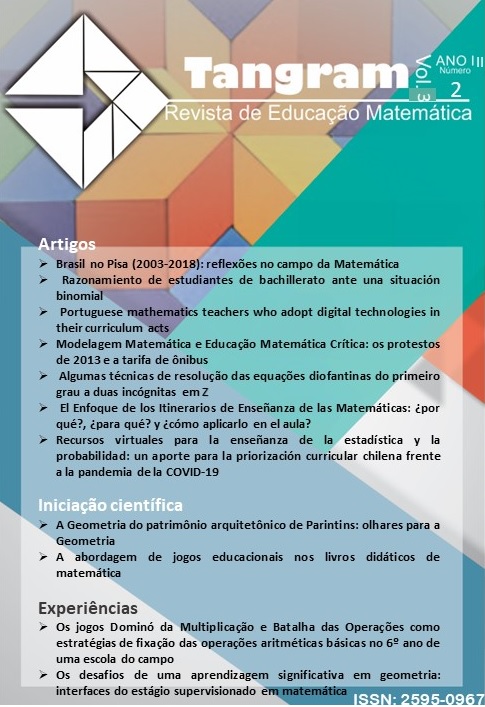Virtual resources for teaching statistics and probability: a contribution to Chile curricular priority in the face of the pandemic COVID-19
DOI:
https://doi.org/10.30612/tangram.v3i2.12299Keywords:
Statistical and probabilistic literacy. Virtual resources. COVID-19.Abstract
Statistical and probabilistic literacy is a priority in the training of citizens, especially in the current situation of the COVID-19 pandemic, in which we are faced daily with the need to interpret information that in one way or another influences our decision-making. Under this perspective, this article in the first part offers an overview of the learning objectives of the statistics and probability axis proposed in the current emergency curriculum in Chile. In the second part, various virtual resources for teaching statistics and probability are presented so that they may be used by teachers to promote in their students critical thinking based on data analysis that allows them to reflect upon the role that each one plays in society and in global well-being.Downloads
References
Arteaga, P. (2011). Evaluación de conocimientos sobre gráficos estadísticos y conocimientos didácticos de futuros profesores (Tesis Doctoral). Universidad de Granada, España.
Batanero, C., y Borovcnik, M. (2016). Statistics and probability in high school. Rotterdam: Sense Publishers.
Contreras, J. M., Díaz, C., Arteaga, P., Gonzato, M., Cañadas, G. (2011). Probabilidad condicional: Exploración y visualización mediante recursos en Internet. Epsilon, 79, 91-100.
Contreras, J. M., Ruiz-Reyes, K., Ruz, F. y Molina-Portillo, E. (2019). Recursos virtuales para trabajar la probabilidad en Educación Primaria. Innoeduca. International Journal of Technology and Educational Innovation, 5(1), 72-80.
Gal, I. (2002). Adults' Statistical literacy: meanings, components, responsibilities. International Statistical Review, Nederland, n. 70, p. 1-25.
Gal, I. (2005). Towards 'probability literacy' for all citizens. In G. Jones (ed.), Exploring probability in school: Challenges for teaching and learning (pp. 43-71). Kluwer Academic Publishers.
Gal, I., y Murray, S. T. (2011). Responding to diversity in users' statistical literacy and information needs: Institutional and educational implications. Statistical Journal of the International Association for Official Statistics, 27(3-4), 185-195.
Godino, J. D., Contreras, A. y Font, V. (2006). Análisis de procesos de instrucción basado en el enfoque ontológico-semiótico de la cognición matemática. Recherches en Didactiques des Mathematiques, 26(1), 39-88.
Godino, J., Wilhelmi, M. y Bencomo, D. (2005). Suitability criteria of a mathematical instruction process. A teaching experience of the function notion. Mediterranean Journal for Research in Mathematics Education, 4(2), 1-26.
IFLA UBCIM Programme. (1997). ISBD (ER): International Standard Bibliographic Description for Electronic Resources: Revised from the ISBD (CF), International Standard Bibliographic
Description for Computer Files (Vol. 17). KG Saur Verlag Gmbh & Company.
MINEDUC. (2012). Bases Curriculares Matemática 1º a 6º de Educación Básica. Unidad de Curriculum y Evaluación: Santiago, Chile.
MINEDUC. (2016). Bases Curriculares Matemática 7º de Educación Básica a II de Educación Media. Unidad de Curriculum y Evaluación: Santiago, Chile.
MINEDUC. (2019). Bases Curriculares Matemática III y IV de Educación Media. Unidad de Curriculum y Evaluación: Santiago, Chile.
MINEDUC. (2020a). Fundamentos Priorización Curricular. Unidad de Curriculum y Evaluación: Santiago, Chile.
MINEDUC. (2020b). Priorización Curricular Matemática. Unidad de Curriculum y Evaluación: Santiago, Chile.
NCTM. (2003). Principios y estándares para la educación matemática. Sevilla: SAEM Thales.
OECD (2019). OECD Future of Education and Skills 2030: OECD Learning Compass 2030. Paris: OECD. Recuperado de http://www.oecd.org/education/2030-project/teaching-and-learning/learning/core-foundations/Core_Foundations_for_2030_concept_note.pdf
Reimers, F., y Schleicher, A. (2020). Un marco para guiar una respuesta educativa a la pandemia del 2020 del COVID-19, CIAE, Universidad de Chile, OCDE.
Ruiz-Reyes, K. (2013). Análisis de recursos en internet para la enseñanza de la probabilidad en la educación primaria. Trabajo fin de master, Universidad de Granada.
Ruiz-Reyes, K., Contreras, J. M., Ruz, F. y Molina-Portillo, E. (2019). Recursos virtuales para la enseñanza de la probabilidad en educación primaria. En J. M. Contreras, M. Gea, M. López-Martín y Molina-Portillo, E. (Eds.), Actas del Tercer congreso Internacional Virtual de Educación Estadística (pp. 1-10). Universidad de Granada.
Vásquez, C. y Alsina, A. (2017). Aproximación al conocimiento común del contenido para enseñar probabilidad desde el modelo del conocimiento didáctico-matemático. Revista Educación Matemática; Volumen 29(3), p.79-108. DOI: 10.24844/EM2903.03
Vásquez, C. y Alsina, A. (2019). Conocimiento especializado del profesorado de educación básica para la enseñanza de la probabilidad. Profesorado, Revista de Currículum y Formación del Profesorado, 23(1), 393-419. DOI:10.30827/profesorado.v23i1.9160
Downloads
Published
How to Cite
Issue
Section
License
Authors must accept the publication rules when submitting the journal, as well as agree to the following terms:
(a) The Editorial Board reserves the right to make changes to the Portuguese language in the originals to maintain the cultured standard of the language, while respecting the style of the authors.
(b) Authors retain the copyright and grant the journal the right to first publication, with the work simultaneously licensed under the Attribution-NonCommercial-ShareAlike 3.0 Brazil (CC BY-NC-SA 3.0 BR) that allows: Share - copy and redistribute the material in any medium or format and Adapt - remix, transform, and create from the material. CC BY-NC-SA 3.0 BR considers the following terms:
- Attribution - You must give the appropriate credit, provide a link to the license and indicate whether changes have been made. You must do so under any reasonable circumstances, but in no way that would suggest that the licensor supports you or your use.
- NonCommercial - You may not use the material for commercial purposes.
- Sharing - If you remix, transform, or create from material, you must distribute your contributions under the same license as the original.
- No additional restrictions - You may not apply legal terms or technological measures that legally restrict others from doing anything that the license permits.
(c) After publication, authors are allowed and encouraged to publish and distribute their work online - in institutional repositories, personal page, social network or other scientific dissemination sites, as long as the publication is not for commercial purposes.






